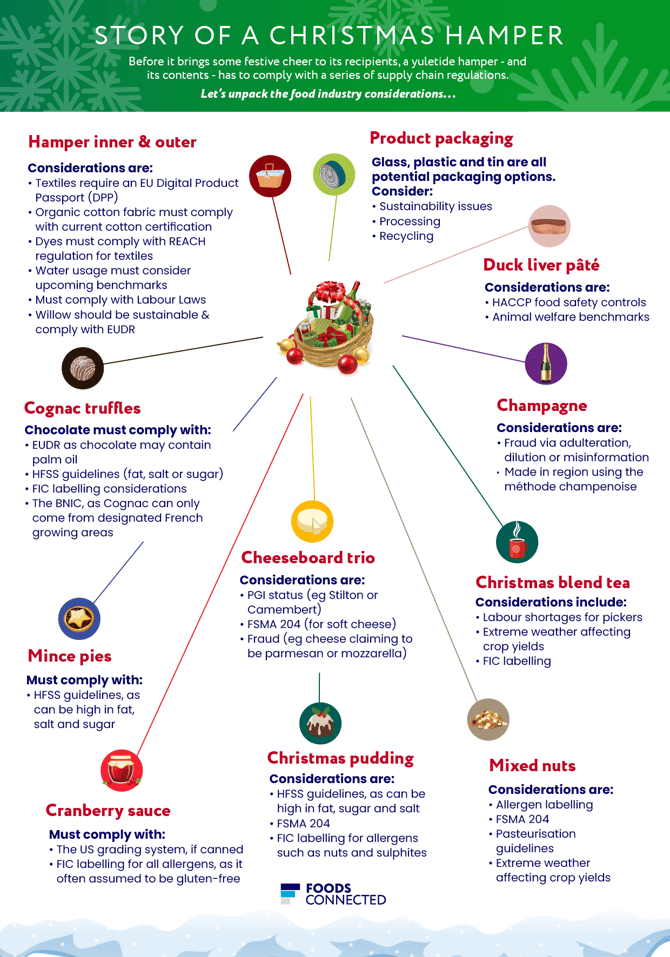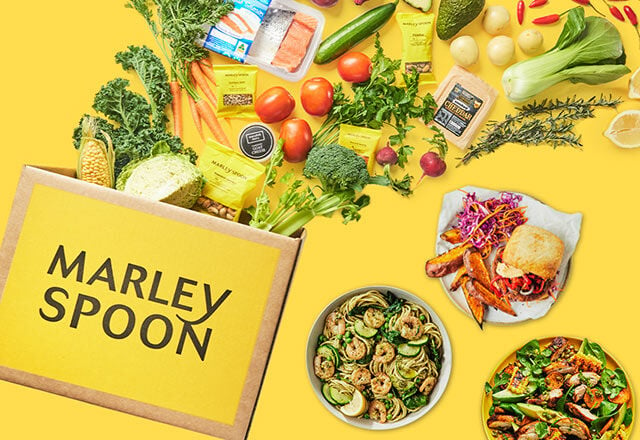With the festive season now upon us, we explore the regulations affecting the supply chain of a festive favourite - the Christmas hamper.
Every year food supply chains are affected by a number of factors. The weather, regulations, world events and consumer demand all define what ends up on supermarket shelves and for how long.
The Christmas period is one of those times when demand peaks putting extra pressure on the food supply chain. Consumers are more adventurous with their spending and products can go viral leading to a bump in sales. This leaves retailers having to deliver the basics that consumers need as well as the luxuries that they want.
On top of all this, retailers also have to consider the regulations that affect their access to these products. So, to understand just how these impact the supply chain as well, we’ve tracked back some of the items, from seasonal standards like the trusty Christmas pudding to indulgent extras like Cognac truffles, that while not in baskets all year round, come together in Christmas hampers to make consumers smile.
Here’s a breakdown of the regulations that retailers need to consider when procuring these items:

💡Right click and open image in new tab to zoom and save the infographic
Assessing the contents, it’s immediately clear that everything in the hamper is liable to some sort of regulation.
HFSS – the UK’s high fat, sugar and salt legislation – affects many of the hamper's sweet treats like the festive mince pie. In fact, attention in this area has led to some manufacturers tweaking their traditional recipes to comply.
EUDR – the EU’s controversial Deforestation Regulation – scrutinises the origins of ingredients including palm oil, cocoa, coffee and soya, many of which would be ingredients used in the hamper's goodies.
The US FSMA 204 rule requires additional recordkeeping to protect public health across a number of foods. This include soft cheeses, such as Brie, Camembert and Goats Cheese, which all feature on dining tables at Christmas.
Also worth considering are the protected geographical indicators (PGIs) and regional governing bodies, which also affect the quality of hamper’s contents. This is to ensure that quality products, such as Champagne and Cognac, that are targeted by fraudsters, meet the correct criteria and maintain the high standards associated with the product name.
Finally there are factors that while not regulations still impact the supply chain journey of the hamper’s products. Animal welfare benchmarks will play a role in the production of items like the duck liver pate, extreme weather can reduce the availability of crops such as almonds and tea, and correct allergen labelling will ensure consumer safety for products such as the cranberry sauce and the mixed nuts.
We dig deeper into how changing regulations are shaping the food industry's traceability journey in our report on the subject. Download your copy to get all the insights.
.jpg)
Greer McNally
Greer has over 15 years’ experience writing about trends in the food and retail sectors. She lives in a little village by the sea in Northern Ireland and loves creating content that informs how people think about the food industry. A recent career highlight was interviewing the legend that is Dr Temple Grandin.
Stay up to date
Stay up to date
Browse Posts
- December 2025
- November 2025
- October 2025
- September 2025
- August 2025
- July 2025
- June 2025
- May 2025
- April 2025
- March 2025
- February 2025
- January 2025
- December 2024
- November 2024
- October 2024
- September 2024
- August 2024
- July 2024
- June 2024
- May 2024
- April 2024
- March 2024
- February 2024
- January 2024
- December 2023
- November 2023
- October 2023
- September 2023
- August 2023
- July 2023
- June 2023
- May 2023
- April 2023
- March 2023
- December 2022
- November 2022
- October 2022
- September 2022
- August 2022
- July 2022
- June 2022
- May 2022
- April 2022
- March 2022
- February 2022
- January 2022
- December 2021
- November 2021
- October 2021
- August 2021
![[Infographic] Story of a Christmas hamper: a regulation rundown](https://blog.foodsconnected.com/hubfs/Blog%20Imagery%20(PI%20AUTOMATED)/Blog%20Headers/Blog%20Header_Story%20of%20a%20hamper.png)

/Blog%20Headers/shutterstock_1927957907%20(1).jpg)
/Blog%20Headers/shutterstock_1845178195%20(2).jpg)
/Blog%20Headers/shutterstock_2473376713.jpg)
/Blog%20Headers/shutterstock_2133827717%20(1).jpg)
/Blog%20Headers/shutterstock_2247276303.jpg)
.png)
.png)



.png)
.png)
/Blog%20Headers/Whitbread%20CS%20Blog%20Header.jpg)
.png)
.jpeg)

/Blog%20Headers/Duncan%20Spencer%20Brown.png)
/Blog%20Headers/Maria%20Castanheira-large%20(1).jpg)
/Blog%20Headers/crispy%20bunny.png)